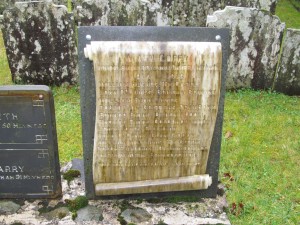Longing for Peace
A notable feature on the WW1 memorials in Wales was that they contained poetry as part of the inscription. Sometimes it is something written specially for the memorial by a local poet, as is the englyn on the memorial in the graveyard of Llwynyrhwrdd Congregational church near Tegryn, North Pembrokeshire
O sŵn corn ac adsain cad – huno maent.
Draw ymhell o’u mamwlad:
Gwlith calon ga glewion gwlad
Wedi’r cur, mwynder cariad.
[From the sound of the trumpet and the noise of battle – they sleep
far away from their motherland;
the brave of the land receive the dew of the heart,
after the hurt, the gentleness of love.]
This englyn is by John Brynach Davies, or “Brynach”, to use his bardic name. Brynach was a newspaper correspondent and an active member of this church, whose poetic compositions were numerous, competing in local eisteddfodau and celebrating local events. It was natural that he should contribute in this way and although his name is not on the memorial, there is no doubting that he was the author since the englyn appears in Awelon Oes, a compilation of his poetry published after his death in 1925 at a relatively young age. A note alongside the poem states ‘From the memorial stone to soldiers in Llwynyrhwrdd.’
At other time the inscription on the memorials will be a line from a poem by a well known poet, as is this quotation from a famous englyn by Ellis Evans, or ‘Hedd Wyn’, to use his bardic name. I have seen this line on memorial stones in the south-west in Aberbanc, Newcastle Emlyn and Pencader, and it would be interesting to know of other places where it is used as an inscription.
Eu haberth nid â heibio [Their sacrifice will not be passed by]
As Alan Llwyd and Elwyn Evans explain in their volume Gwaedd y Bechgyn: Blodeugerdd Barddas o Gerddi’r Rhyfel Mawr 1914-1918, he composed this englyn in 1916 in memory of Tommy Morris, a friend who died in France. Hedd Wyn was commemorating one person – the singular is used in the original poem , ‘his sacrifice’ – but memorials changed the singular to the plural, ‘their sacrifice’.
Ei aberth nid â heibio – ei wyneb
Annwyl nid â’n ango,
Er i’r Almaen ystaenio
Ei ddwrn dur yn ei waed o.
[His sacrifice will not be passed by –
his dear face will not be forgotten,
although Germany has stained
its steel fist in his blood.]
Sacrifice is not the only theme seen in these poems. Another is the memory of those who were lost will last for ever. One of the most popular quotations on this theme comes from the works of John Ceiriog Hughes, “Ceiriog”, which I have seen on 12 memorials in the south-west. .
Mewn angof ni chânt fod. [They shall not remain in oblivion.]
On two other memorials there is a slight variation of the same line.
Yn angof ni chânt fod. [They will not be forgotten.]
This quotation comes originally from a stanza in the poem Dyffryn Clwyd .
Mewn Anghof ni chânt fod,
Wŷr y cledd, hir eu clod,
Tra’r awel tros eu pennau chwŷth:
Y mae yng Nghymru fyrdd,
O feddau ar y ffyrdd,
Yn balmant hyd ba un y rhodia rhyddid byth!
[They shall not remain in oblivion,
men of the sword, much praised
while the wind blows over their heads:
there are in Wales a multitude
of graves along the ways,
a pavement on which freedom forever walks.]
Ceiriog died in 1887, without seeing the massacre of the First World War and is referring to heroes of a past age. But the use of this line on the inscription implies that the dead remembered there were themselves heroes who had earned their place in the same tradition of a deserved remembrance.
It’s not surprising to see poems such as these. They reinforce the theme of the memorial and are in keeping with the desire to remember the bravery and sacrifice of those lost. But occasionally a different kind of poem appears – a poem that rejects military values and longs for peace. So far I have only seen two such memorials, one on a memorial in Llanilar near Aberystwyth, and another on a memorial at Llangynog near Carmarthen.
The wording on the Llanilar memorial in memory of one local man in a simple and fitting if one looks at the couplet which comes at the end of the inscription. I have been unable to find the name of the poet, but his feelings are quite clear. There is no war in a civilized world, and it is peace alone which praises God.
Ior Nef! Gwna di i ryfel beidio a bod,
A’r gwaedlyd gledd i rydu er dy glod.
[Lord of Heaven! Make war cease to be,
and let the bloody sword rust in your honour]
The inscription is entirely in Welsh and the feelings expressed publicly here, grieving the loss from the community of a young man and yearning to see an end to war, appear to be in agreement with the opinion of the community.
The situation in Llangynog is slightly different, although the poem quoted is similar in respect of conviction. 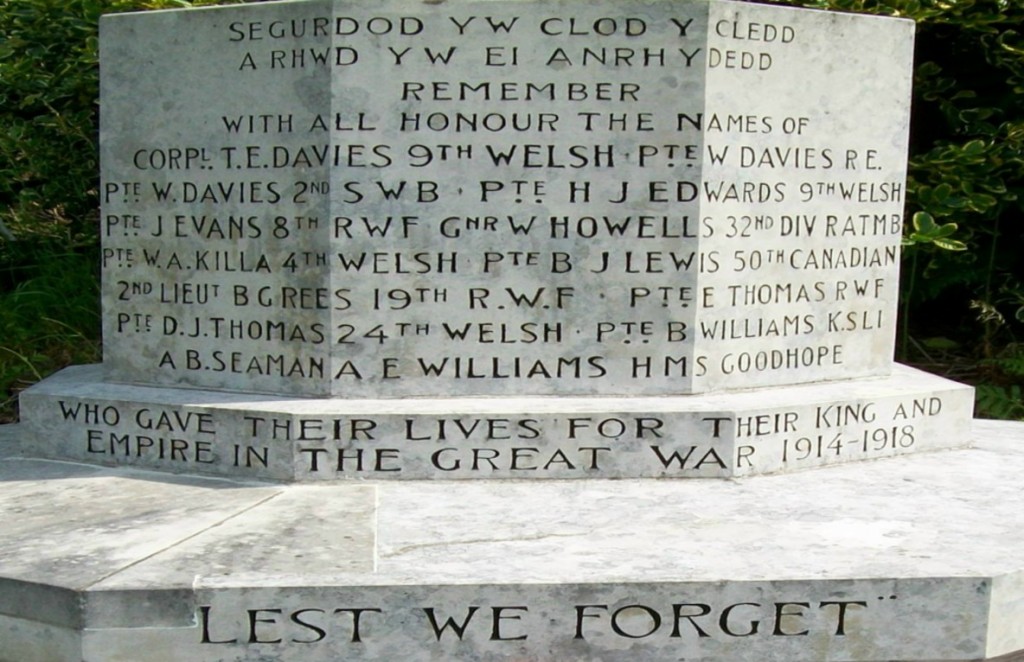 Here the inscription is in English and more warlike in its sentiment, with the soldiers who died having fought for their king and empire. But this is not the message proclaimed by the Welsh couplet on the memorial.
Here the inscription is in English and more warlike in its sentiment, with the soldiers who died having fought for their king and empire. But this is not the message proclaimed by the Welsh couplet on the memorial.
Segurdod yw clod y cledd,
A rhwd yw ei anrhydedd.
[Idleness is praise for the sword
and rust is its honour.]
This couplet comes from the famous englyn of William Ambrose, ‘Emrys’, which preaches uncompromising pacifism.
Celfyddyd o hyd mewn hedd – aed yn uwch
O dan nawdd tangnefedd;
Segurdod yw clod y cledd,
A rhwd yw ei anrhydedd.
[Skill always in peace – may it increase
under the patronage of peace;
Idleness is the praise for the sword
and rust is its honour.]
Did the people who framed the English wording with its military ostentation on the memorial understand the point of this quotation in Welsh? What happened in Llangynog that a memorial should be created which lauded war in one language but opposed it in the other?
Are there other examples of such poems on W.W.1 memorials in Wales which look forward to a future of civilized peace and an end to warring. And are there similar sentiments to be seen in English on memorials, either here in Wales or across the border? I’ve seen no such references, but it’s worth asking and searching.
Gwen Awbery
Cardiff
g.h.matthews June 3rd, 2016
Posted In: Uncategorized
The Mond Nickelworks WW1 Memorial
For well over a century, the Mond nickelworks has been a major landmark and an important employer for the people of Clydach, in the lower Swansea valley. The works first produced nickel in 1902, using a process pioneered by a German chemist-entrepreneur named Ludwig Mond whose statue stands nearby, surveying his creation. Although the ownership of the works has changed over the decades, so that it is now operated by Vale, a Brazilian company, to locals it is simply ‘the Mond’.
On the way into the Mond Community Centre (attached to the works) you walk past two memorials, commemorating the 33 men associated with the company who died in the First World War, and the 19 who were killed in the Second World War.
The number of names on the WW1 memorial is striking, although it is only a fraction of the 450 Mond employees who volunteered or (after 1916) were conscripted into the armed services. The figures indicate that 250 employees (out of 850) volunteered to serve in the Armed Forces in the first few months of the war. Besides any other reasons for volunteering, they were encouraged and supported by the company’s management, who promised to pay half-wages to the families of married volunteers, and also to support the dependents of single men who joined up. Of course, the product of the Mond, refined nickel, was in high demand at wartime and it was a profitable time for the company. For more details of this, see this blog from 2014 on the BBC’s website.
One consequence of the flow of men from the Mond into uniform was that women were recruited to work in the manufacturing process for the first time: thus the list of names on the memorial is only part of the story of how the war affected the local community.
Excellent research work by local historian Bill Hyett into the details of the 33 men who died shows some interesting patterns that need to be carefully examined and explained. 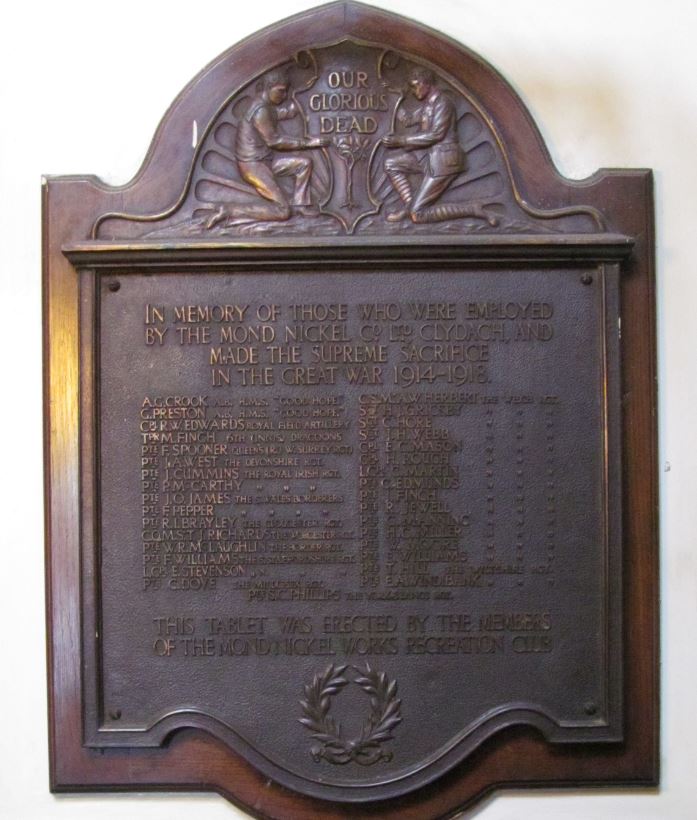 Mr Hyett has found biographical and service details of all but one of the men. The statistic that stands out from this research is that over two thirds of them – 23 – were English-born. A further three were Irish-born, meaning that only six were Welsh-born. This does not reflect the general workforce at the Mond, where the majority of the names on the employment register are clearly Welsh.
Mr Hyett has found biographical and service details of all but one of the men. The statistic that stands out from this research is that over two thirds of them – 23 – were English-born. A further three were Irish-born, meaning that only six were Welsh-born. This does not reflect the general workforce at the Mond, where the majority of the names on the employment register are clearly Welsh.
A clue to explain this discrepancy can be found when studying the patterns of when these servicemen were killed. Of the four who died in 1914,three were English and one Irish; in 1915, ten English and one Irish were killed; all of the seven casualties in 1916 were English-born. Then in 1917 three English-born and three Welsh-born died; in 1918 two Welsh and one Irish and the final casualty, who died in 1919, was Welsh.
This demonstrates that most of those who joined up earliest in the war, and who were thus most likely to be killed in it, were English-born. Most of these had lower-paid unskilled jobs at the plant, and some had not been working there very long. One example is Reginald Edwards, born at Erdsley, Hereford. His employment at the Mond was very brief, as he started work on 11 August 1914 and volunteered for the Royal Field Artillery in September 1914. Thus those who were most likely to join up early in the war were the unskilled labourers, many of whom had moved to Clydach from England. The local-born workers often had better-paid, higher-skilled jobs, and so were less likely to volunteer for the armed forces.
Here are details from Mr Hyett’s magnificent research of two individuals which give an idea of the human stories behind the list of names on the metal plaque. The first of the Mond casualties was Tipperary-born Peter McCarthy, who was about 25 years old when he began work at the Mond in March 1914. He must have been an army reservist, called up in August 1914, for he was killed on the Western Front on 7 October 1914: he has no known grave.
The final Mond casualty was Sidney Phillips (noted on the memorial as S. C. Phillips, though Mr Hyett’s research has shown that his middle name was George). He was Swansea-born and lived in Ebenezer Street, Swansea with his wife and three children. Sidney was one of those who volunteered in 1914, initially serving with the Welsh Regiment before transferring to the York and Lancs Regiment. He suffered a gun-shot wound to the thigh in May 1916 but recovered, only to fall victim to a gas attack in France. He was invalided home and discharged from the army in September 1918, but died on 17 April 1919 and received a military funeral in Swansea’s Dan-y-Graig cemetery.
g.h.matthews May 23rd, 2016
Posted In: Uncategorized
Patterns of Memorialisation
One of the patterns that has become clear as we gather material from around Wales for the ‘Welsh Memorials’ project is that patterns of memorialisation can be local. That is, particular communities in certain areas will have the same kinds of memorials to those who served in the First World War.
One example can be seen in the nonconformist chapels of Morriston. Another blog post looks at these in more detail – look at how similar the various chapel memorials are.
These five memorials have all been designed by the same man, and they all have an image of the chapel building to the fore, flanked by the Union flag and the Welsh dragon.
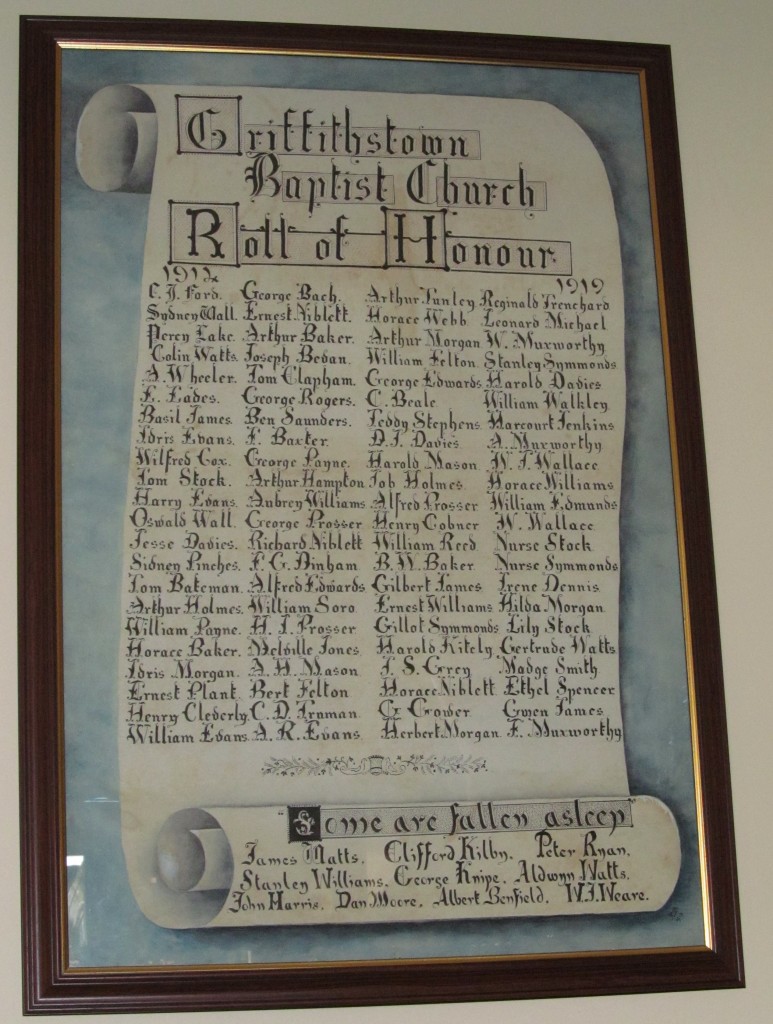
Another patch of Wales where a number of interesting chapel memorials have survived is the Pontypool area. Below are five examples of memorials from Baptist chapels in the area which, although different in design, share some important features.
The memorial in Ebenezer Baptist chapel, Griffithstown (south of Pontypool), was designed by Mrs K. Davies, the minister’s wife, and was unveiled in March 1919. It lists the names of 78 men and then ten women who served, and then names the ten men who died on active service. (The final woman on the list is F. Muxworthy: this is almost certainly Frances Muxworthy of Kemeys Street, Griffithstown, who served with Queen Mary’s Army Auxiliary Corps. This also suggests that two of the men listed are her brothers, Arthur and William Muxworthy).
In Merchant’s Hill Baptist chapel, Pontynewynydd, a Roll of Honour was unveiled in 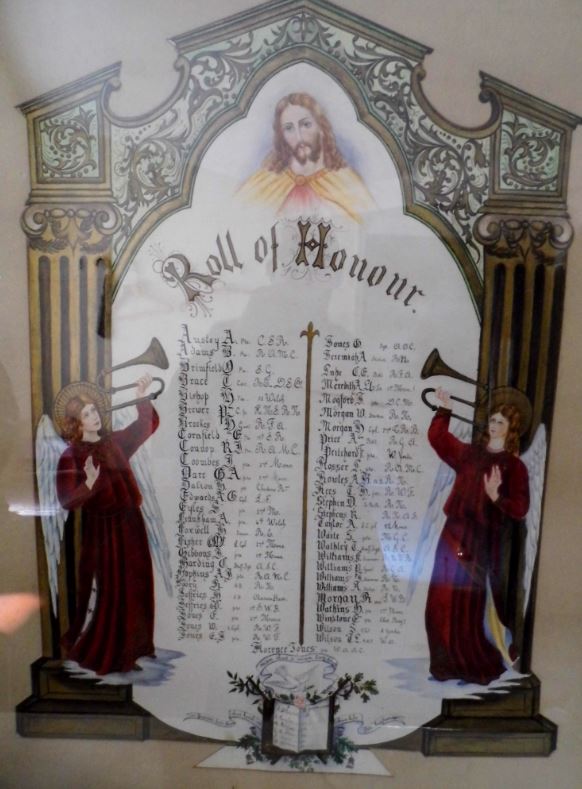 October 1919, naming five men who died, and 47 men and one woman who served.
October 1919, naming five men who died, and 47 men and one woman who served.
There is also in this chapel a memorial which names six men and one woman who died.
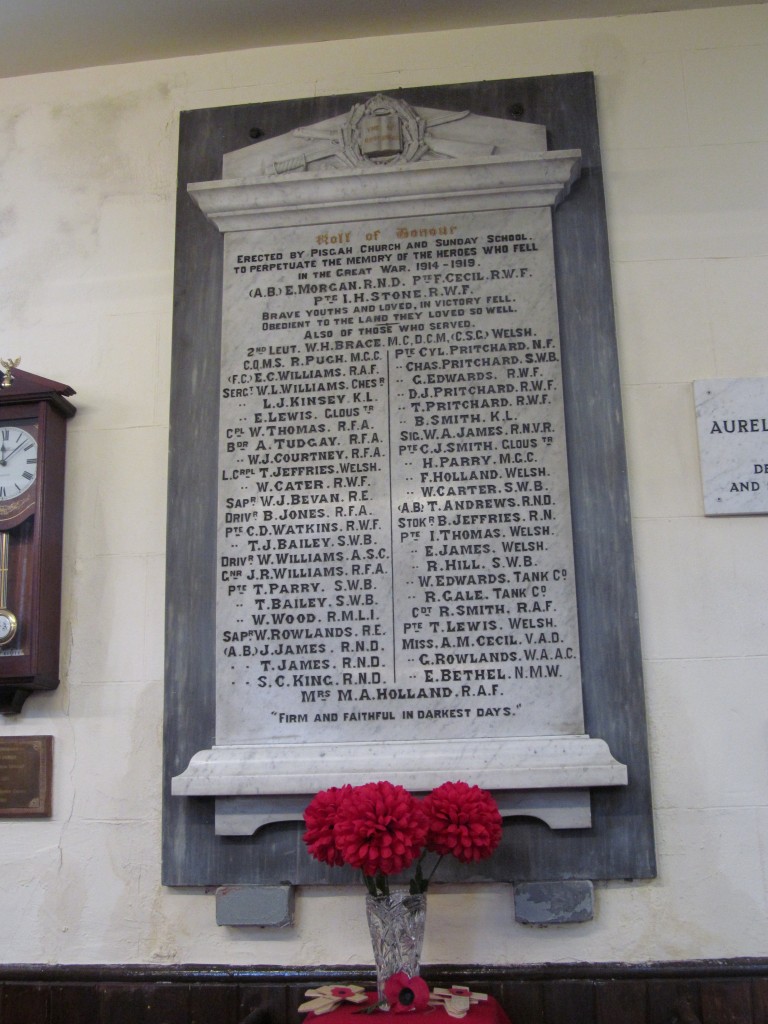
Moving north of Pontypool to Talywain, there is Pisgah chapel. Here the memorial is in marble, and it lists three men who were killed in action, and then gives the names of 44 men and four women who served.
Just down the road in Abersychan there is the High Street English Baptist chapel.
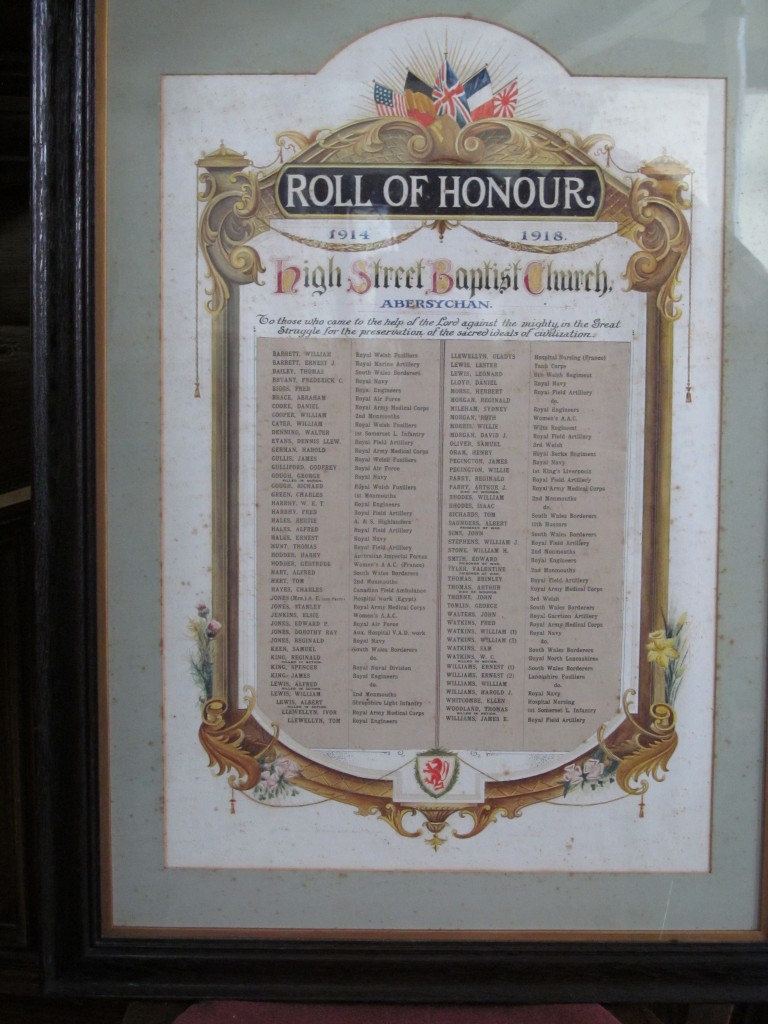
The list here is alphabetical (unlike the list in the others mentioned here) and it contains 85 names, including seven women. Eight of the men were killed in the war.
On prominent display in the chapel there is also a marble tablet celebrating the peace that came at the war’s end.
A stone’s throw away from High Street chapel is Noddfa, yet another Baptist chapel. The memorial here lists seven men who died and then the names of 53 other men who served and six women.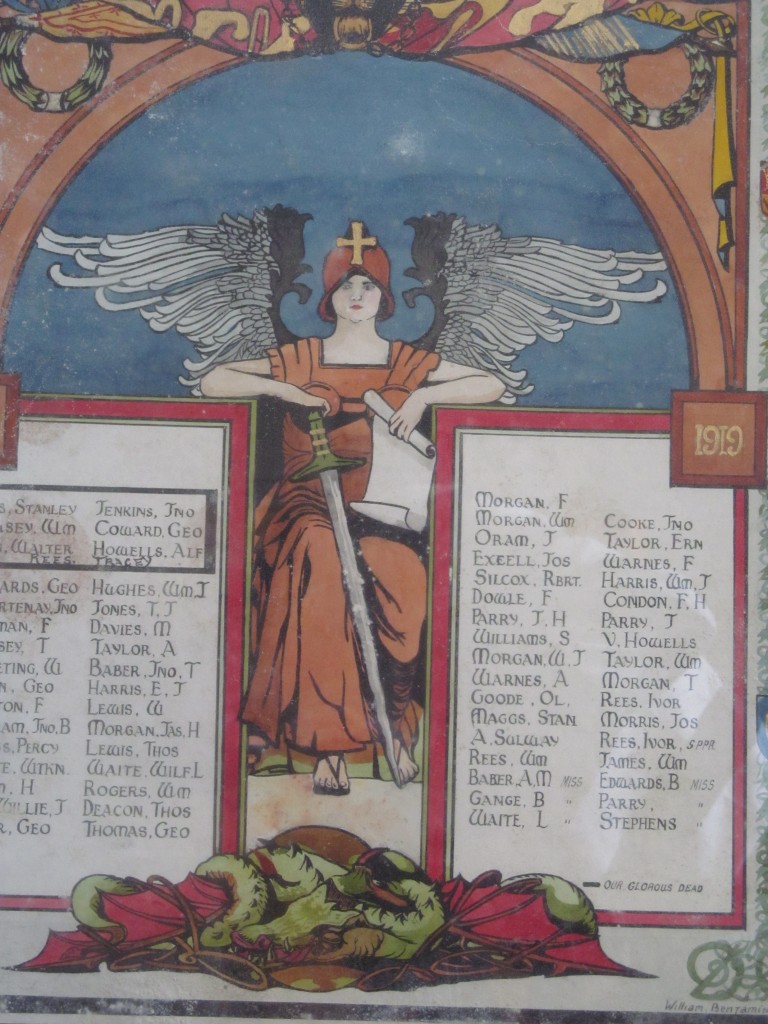
In visual terms, this is obviously the most striking of the five. The memorial, designed by William Benjamin John of Abertillery, has some very strong symbolism. The central figure is an angel; above is a lion with chains in its mouth; at the bottom is a slain dragon. This is probably the most vivid image of a chapel memorial so far collected by the ‘Welsh Memorials’ project.
Having noted the differences in the appearance of the four memorials described, it is also worth dwelling on their similarities. All of these memorials honour those who served, as well as mourning those who died. (Around a half of the Welsh chapel memorials so far gathered are Rolls of Honour which list all who served). All of these memorials name the women who served (mainly as nurses, but also in units such as the Women’s Army Auxiliary Corps) – whereas in general only around a third at most of Welsh chapel Rolls of Honour include the names of women.
Perhaps there is a case of imitation here, or maybe we could even say competition. The chapels were proud of their communities’ contribution to the war effort and they wanted to demonstrate it. Thus as well as the clear motivation of honouring those who served in the war, there was also an element of pride in both the execution of the memorial and in the length of the list of chapel members who had ‘done their duty’.
g.h.matthews May 9th, 2016
Posted In: Uncategorized
The Shields of the Earth: the WW1 memorial in Siloh, Landore
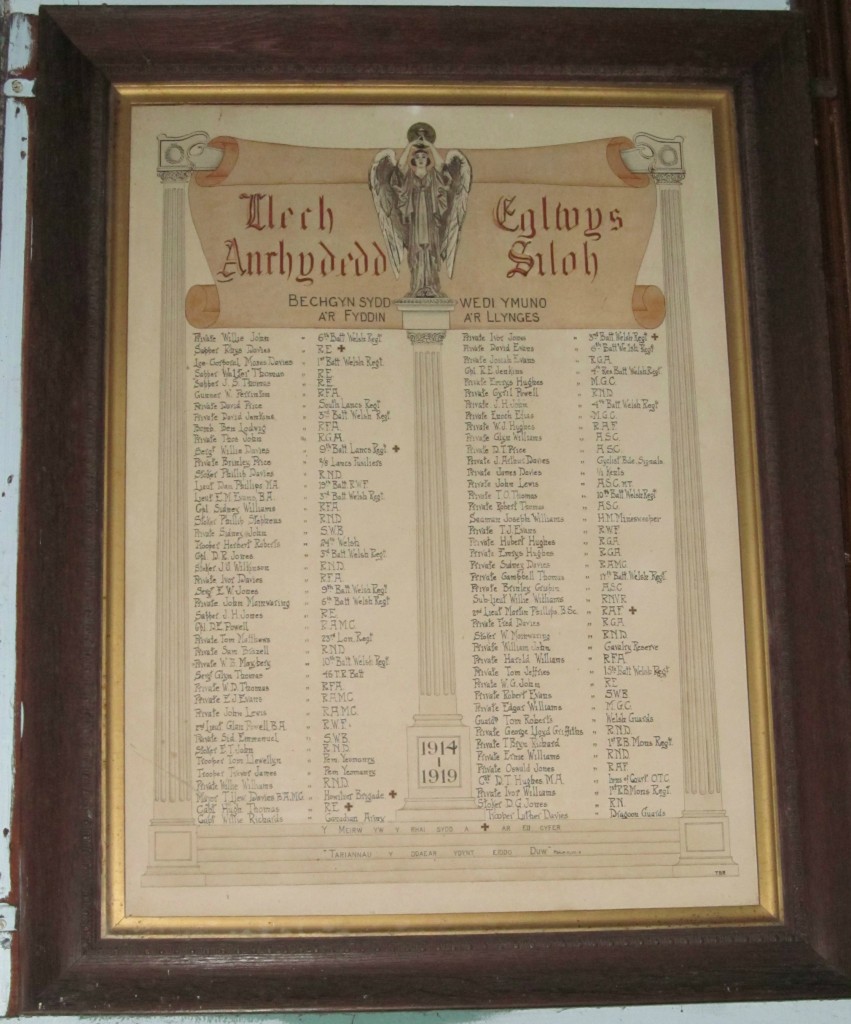
After almost 190 years, the grand Independent chapel of Siloh, in the Landore area of Swansea, closed its doors in January 2016. A hundred years ago the membership stood at around 640; at the end of the Second World War, there were over 600; when the chapel closed, the number of members was in single figures.
In the building’s vestry there was a roll of honour to remember the 84 men of the chapel who served in the armed forces between 1914 and 1918. This figure is not unusal for a chapel memorial in north Swansea – there are, for example, 81 names on the memorial at Caersalem Newydd, Treboeth, and 66 on the memorial at Carmel, Morriston.
The imagery on this memorial is interesting, but again it is similar to other examples. 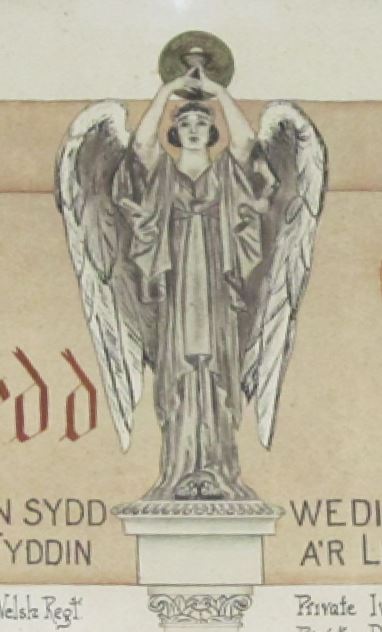 Classical-style pillars can be found flanking the names in the memorials of chapels such as Mynydd Bach (north Swansea), Zoar (Merthyr), Graig (Merthyr), Libanus (Dowlais) and Carmel (Aberdare), to name just five. Similarly, angels adorn the memorials in Zoar (Merthyr), and Noddfa, Abersychan.
Classical-style pillars can be found flanking the names in the memorials of chapels such as Mynydd Bach (north Swansea), Zoar (Merthyr), Graig (Merthyr), Libanus (Dowlais) and Carmel (Aberdare), to name just five. Similarly, angels adorn the memorials in Zoar (Merthyr), and Noddfa, Abersychan.
The Biblical verse (Psalm 47:9) is not one of the common choices: ‘Tariannau y ddaear ydynt eiddo Duw’ (‘the shields of the earth belong unto God’ in the King James version) although similar sentiments can be found on chapel memorials all over Wales.
While looking at the servicemen listed, we know (thanks to the chapel’s annual reports) that 18 volunteered in 1914 and 10 in 1915. Conscription was introduced in early 1916 so we cannot tell how much choice the 25 who joined up that year had, nor the 15 in 1917 nor the 12 in 1918.
 One of the men (Captain Willie Richards) served with the Canadian forces: again, there are plenty of similar examples across Wales of men who served with (in particular) the Canadian or Australian forces. This reflects the substantial emigration that had taken place from Wales to the dominions in the decade up to 1914.
One of the men (Captain Willie Richards) served with the Canadian forces: again, there are plenty of similar examples across Wales of men who served with (in particular) the Canadian or Australian forces. This reflects the substantial emigration that had taken place from Wales to the dominions in the decade up to 1914.
It is not just this ‘llech anrhydedd’ (literally ‘slate of honour’) that indicates the chapel’s viewpoint on the justice of the British cause. Letters were sent every Christmas by the minister, the Rev. Samuel Williams, to the soldiers and sailors of his flock, assuring them that Siloh supported them and prayed for them. When the men returned home on leave, the chapel organised meetings to welcome them: you can read here a report from January 1917 of a meeting when Private Tom Matthews was presented with a fountain pen by the Rev. Williams.
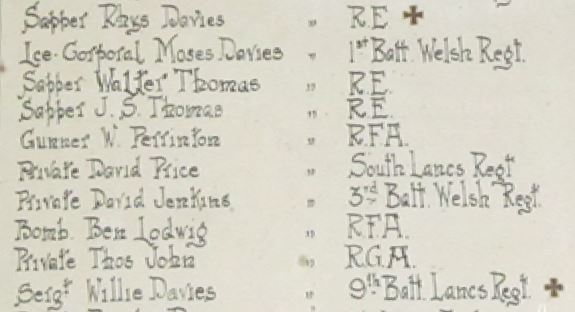 Unlike many other chapel memorials, the names of those who were killed are not listed separately, nor on another memorial, but a cross was added by the names of six men to show that they died in the war.
Unlike many other chapel memorials, the names of those who were killed are not listed separately, nor on another memorial, but a cross was added by the names of six men to show that they died in the war.
Although Siloh has closed its doors as a place of worship for the last time and the building is to be sold, the future of this memorial is secure, as it has been transferred to the care of West Glamorgan Archives.
g.h.matthews April 25th, 2016
Posted In: Uncategorized
The Glamorgan Constabulary Roll of Honour
The ‘Welsh Memorials to the Great War’ project is interested in those memorials which commemorate the service of members of particular communities, be they chapels, clubs, schools or workplaces. Of course, many of these institutions have disappeared or been transformed over the intervening years. In terms of workplaces it is very difficult to find mines or industrial manufactories that are still going concerns.
One institution that still has its place in society is the police force. Here there have been re-organisations, so that the old Glamorgan Constabulary has merged with the formerly independent police forces of Cardiff, Merthyr, Neath and Swansea to form the South Wales Police. The urban police forces have their own memorials to policemen who fell while serving in the First World War, but the focus of this article is the Glamorgan Constabulary.
Outside Police HQ 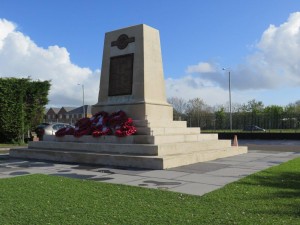 in Bridgend there stands an impressive memorial to the fallen, listing the 58 who were killed in WW1 and 28 who were killed in WW2.
in Bridgend there stands an impressive memorial to the fallen, listing the 58 who were killed in WW1 and 28 who were killed in WW2.
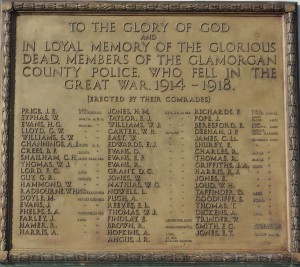
Usually, a striking WW1 Roll of Honour is on display inside the building – 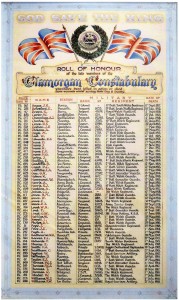 but while some refurbishment is being completed this memorial is currently in the Cardiff station.
but while some refurbishment is being completed this memorial is currently in the Cardiff station.
This impressive memorial lists the 58 names and gives further details of their police service.
The South Wales Police First World War Project Group has been active in researching these men so that it become more than a mere list of names. A series of booklets are being produced, starting off with one which tells the story of those who fell in 1914.
Looking at the booklet about 1915, it is remarkable that five Glamorgan policemen and one Cardiff constable were killed on one day, 27 September 1915, the first day of the Battle of Loos (in Belgium, on the Western Front). Five more south Wales policemen died within a month in that vicinity.
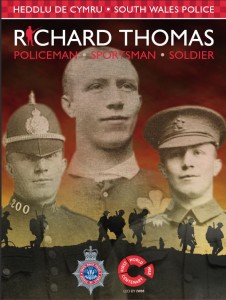
Another booklet tells of the connections between the police forces of South Wales and the Welsh Guards, and one further booklet focusses in on the story of Richard Thomas (known as Dick).
Born in Ferndale in 1881, he was a very well-known sportsman before the war, being capped as a forward four times for Wales between 1906 and 1909. He was part of the Wales team that won the Grand Slam for the first time, when they beat Ireland in March 1908. Although his reputation was as a hard-tackling forward, he occasionally also played as a back for the Glamorgan Police side. To show that he was a real all-rounder, he was also the Glamorgan Police heavyweight boxing champion on three occasions.
In August 1913 Dick was promoted to sergeant and was stationed at Bridgend. However, five months into the War he volunteered for the 16th Battalion of the Welsh Regiment, known as the Cardiff City Battalion. This was part of the ‘Welsh Army Corps’ – raised as part of the recruitment drive headed by Lloyd George with the aim of putting ‘a Welsh army in the field’. After training in Wales, the unit headed off for further training in Winchester before departing for the Western Front as part of the 38th (Welsh) Division.
The division was involved in a major battle for the first time at Mametz Wood, six days into the 1916 Somme campaign. The Cardiff City Battalion were among those ordered to make an assault across open ground to capture the heavily defended wood on 7 July. Dick Thomas was one of the battalion’s 300 casualties that day.
Looking at the Glamorgan Constabulary memorial, you will see details of some others killed in the same battle. Robert Harris (Cardiff City Btn, 7 July 1916), William Edward Trinder (Cardiff City Btn, 7 July 1916) and William Henry Loud (10th (1st Rhondda) Btn, Welsh Regiment, 10 July 1916) were killed as the Welsh took Mametz Wood; Edward Beresford (South Staffordshire Regt, 10 July) was killed nearby in a supporting action.
With thanks to Gareth Madge for his assistance
g.h.matthews April 18th, 2016
Posted In: Uncategorized
Obituaries and Memorials to the Soldiers of Tregarth
Tregarth is a village in the Ogwen Valley, Caernarfonshire. Its Wesleyan Methodist chapel, ‘Shiloh’ and church, ‘St Mary’s’ are still open and have memorials dedicated to those who lost their lives in the First
World War. The church also holds the Sunday school’s memorial and a stained glass window dedicated to the Brock brothers, whose father was the headmaster of the local school. The gates to the church are also a memorial to those from Tregarth who died during both world wars.
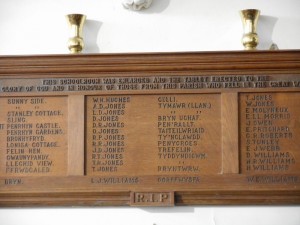 Shiloh’s memorial lists the names and homes of members of the congregation who died fighting the war (for example: Richard Jones – Tyddyn Dicwm). It was necessary to include the street or farm where the fallen had lived, as the community identified them by their place of residence rather than by their surname. Therefore, Richard Jones would probably have been known as Richard Tyddyn Dicwm. The gates outside St. Mary’s and the Sunday school memorial also note where the soldiers had lived in Tregarth. This was also important because a number of the soldiers had the same surname – there are 43 names on the Sunday school memorial, 13 of whom are ‘Jones.’
Shiloh’s memorial lists the names and homes of members of the congregation who died fighting the war (for example: Richard Jones – Tyddyn Dicwm). It was necessary to include the street or farm where the fallen had lived, as the community identified them by their place of residence rather than by their surname. Therefore, Richard Jones would probably have been known as Richard Tyddyn Dicwm. The gates outside St. Mary’s and the Sunday school memorial also note where the soldiers had lived in Tregarth. This was also important because a number of the soldiers had the same surname – there are 43 names on the Sunday school memorial, 13 of whom are ‘Jones.’
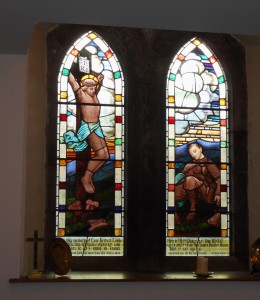
St. Mary’s memorial, by contrast, seems less concerned with remembering the soldiers as part of the local community, and more concerned with showing their important role in the Great War. The memorial does say where the soldiers lived. In the majority of cases it does not record the first names of the deceased. Instead, it lists their rank in the army; first initial; surname; area in which they fell and the year they died. The stained glass memorial to the Brock brothers in St. Mary’s echoes this focus on military accomplishments. Although we know from the Sunday school memorial that they lived at Sunnyside, the inscription on the stained glass makes no reference to this. It reads: ‘In loving memory of Lieut. Herbert Leslie Brock (BA Wales) 20th Div. MGC. Killed in action in France April 10th 1918 age 28, and Private Ivor James Baxter Brock 14th Batt. R. W. F. killed in France Sept. 1st 1917 age 19. “Greater love hath no man than this that a man lay down his life for his friends.” S. John XV 13.
Different memorials commemorated men in different ways, and the same can be said of newspaper obituaries. This project seeks (among other things) to analyse memorials from all over Wales to see if it is possible to identify patterns in their styles and wording. For example, was including the soldier’s home address on a memorial a trait unique to north Wales, or was it common across rural Wales? Did all Anglican churches note where and on what date members of their congregation had been killed in action? Further research also needs to be done on whether the religious denomination or political outlook of the newspapers had an influence on the style of obituary they published.
Below are examples of Tregarth men’s obituaries from three newspapers. Y Llan was a bilingual Anglican newspaper, whilst Y Gwyliedydd Newydd was Wesleyan. Y Genedl was more political than religious. It supported the Liberal party, but welcomed contributions which reflected the socialist point of view.
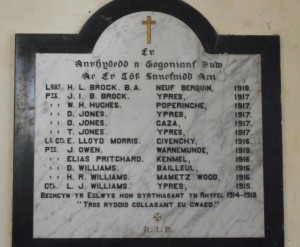
Both Y Llan and Y Genedl’s obituaries seem to stress that the fallen were brave men who had fallen for king and
county. Whilst Y Llan (28/4/1916, p. 7) extended its deepest sympathy to David Williams’s whole family, especially his widow, his young children and his mother, they believed that ‘ond y mae cysur i’w gael wrth feddwl ei fod wedi marw wrth wneud ei ddyletswydd’ (but there is comfort to be had in the thought that he has died doing his duty). A month later, Y Genedl (23/5/1916, p. 8) was even more emphatic that the soldiers were dying for a just cause. It’s article was about a memorial service to Richard Price Jones, but in the middle of the article it refers to all soldiers involved in the war: ‘Da gweled yr ardalwyr yn gollwng dagrau hiraeth, ac o barch, ar ôl y bechgyn sydd yn rhoddi eu bywydau i lawr i gadw y gelynion rhag gwneud ein gwlad fel Belgium, Serbia a Pholand.’ (It is good to see the locals shedding tears of loss and of respect for the boys who have given their lives to prevent the enemy from making our country like Belgium, Serbia and Poland.’) Richard Price Jones’s memorial service was held at the Calvinistic Methodist chapel in Tregarth, but unfortunately I do not know if the chapel is still in use or if any memorials are preserved there.
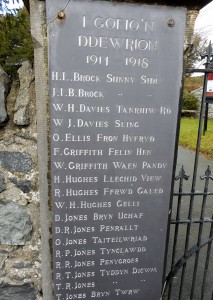
By contrast, the obituaries in Y Gwyliedydd Newydd seemed less certain that the Great War was a just cause that was worth the cost. It also acknowledged that not all soldiers on the battlefield wanted to be there. My research so far has not been very extensive, so the first obituary I found relating to a soldier from Capel Shiloh is from September 1916. Conscription had been introduced in March 1916, and attitudes towards the war in Britain as a whole were less fervently patriotic than in the hopeful days of 1914. Also, as Dafydd Roberts has explained in his article, ‘”Dros ryddid a thros ymerodraeth” Ymatebion yn Nyffryn Ogwen 1914-1918’ (“For Freedom and for Empire: reaction in the Ogwen Valley 1914-1918,’ Caernarvon Historical Society Transactions, 1988-9 p. 107- 123), the residents of the Ogwen valley had been reluctant to enlist since the outbreak of war. Methodism in pre-1914 Wales had a strong pacifist tradition, which may also have influenced the newspaper’s views about the war. Y Gwyliedydd Newydd’s coverage of Rowland Hughes’s memorial service (12/9/16, p. 6) refers to the battlefield as ‘faes y gyflafan ofnadwy’ (the field of awful massacre). When Owen Ellis was killed at the front, the paper (30/1/1917, p. 7) played with the phrase ‘maes y gad’ (battlefield) calling it instead ‘maes y gwaed’ (field of blood). By the time David Richard Jones was killed (2/7/1918, article published 24/7/1918, p. 8), Y Gwyliedydd Newydd was referring to the whole war as ‘y gyflafan erchyll yma’ (this horrific massacre).
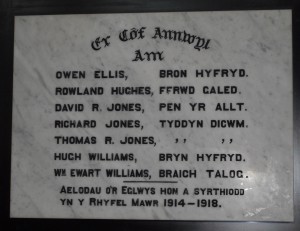
In two articles about members of Shiloh’s congregation who had died at the front, the paper makes it quite clear that they had not enlisted because they believed in the glory of war. The first, Rowland Hughes’s (12/9/16, p. 6), stated that he ‘Ymunodd a’r fyddin o argyhoeddiad dwfn. Methai a chysgu’r nos gan faint bwysai ar ei feddwl. Cychwynnodd i’r chwarel at ei waith, troes yn ei ôl, a cherddodd i Fangor i ymuno a’r fyddin, – “yr wyf i fod i listio, meddai, i ymladd dros gyfiawnder.” (He joined the army from deep conviction. He could not sleep at night because of the weight on his mind. He started towards his work at the quarry, turned around, and walked to Bangor to enlist in the army, – “I am going to enlist, to fight for justice”.) Although he had eventually decided to fight for his principles, the newspaper makes it clear that this was not an easy decision to make. The second example is Owen Ellis (30/10/17, p. 7). When describing his character, Y Gwyliedydd Newydd said he was: ‘un o’r bechgyn tyneraf ei ysbryd, a pharatoaf ei gymwynas. Er iddo farw’n filwr ar faes y gwaed, nid milwr mohono wrth anianawd. Yr oedd o duedd enciliedig, gwell ganddo wrando na llefaru. Er hynny, pan alwyd arno i gyflawni’r annymunol gwnaeth hynny yn ffyddlon a theyrngarol. Da gennym glywed gan ei Gaplan iddo farw fel y bu fyw, yn llawn arwriaeth.’ (He had one of the gentlest souls, and was always happy to help. Although he died a soldier on the field of blood, he was not a soldier at heart. He was of a retiring nature, preferring to listen than to preach. Despite this, when he was called upon to do the objectionable he did that faithfully and loyally. We are glad to hear from his Chaplain that he died as he lived, full of heroism.) Although this extract refers to Owen ‘doing his duty’ and ‘dying a hero’ it also, I think, makes it explicitly clear that he should not have died ‘on the field of blood.’
This article has only looked very briefly at the some of the memorials in one village. There is far more scope for others to find out more about the memorials and obituaries in their own local communities.
Meg Ryder April 11th, 2016
Posted In: chapels / capeli, memorials
Tags: Dyffryn Ogwen, Tregarth
The Monmouthshire Regiment and the Battle of Frezenberg Ridge by Shaun McGuire
It is possible that the total of 85 men from Newport killed on 8 May 1915 is the greatest loss suffered by any Welsh town in a single day in the First World War. They were part of the Battle of the Frezenberg Ridge, which was part of what has become known as the Second Battle of Ypres.
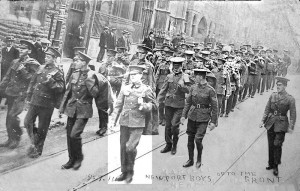 This photograph shows men marching down Stow Hill from the Drill Hall in the summer of 1914: the caption says ‘Newport boys off to the front’. The man highlighted at the front is Job William White, who was one of those killed on 8 May 1915. Further behind him is John Albert Pope, who was killed three years after the photograph was taken – on 17 June 1917. It was at the Drill Hall in Stow Hill, Newport that the First Battalion of the Monmouthshire Regiment recruited soldiers, and these men (along with the other two battalions in the regiment) became heavily involved in the second Battle of Ypres, which began on 22 April 1915.
This photograph shows men marching down Stow Hill from the Drill Hall in the summer of 1914: the caption says ‘Newport boys off to the front’. The man highlighted at the front is Job William White, who was one of those killed on 8 May 1915. Further behind him is John Albert Pope, who was killed three years after the photograph was taken – on 17 June 1917. It was at the Drill Hall in Stow Hill, Newport that the First Battalion of the Monmouthshire Regiment recruited soldiers, and these men (along with the other two battalions in the regiment) became heavily involved in the second Battle of Ypres, which began on 22 April 1915.
On 8 May the Monmouthshire Regiment were trying to defend the Frezenberg Ridge from a ferocious German attack. By the end of the day, the Regiment had lost 211 men and officers – 150 from the First Battalion, 19 from the Second and 42 from the Third. By the end of May the three battalions had lost a total of 515 men, with the Third Battalion suffering the greatest losses.
It was during this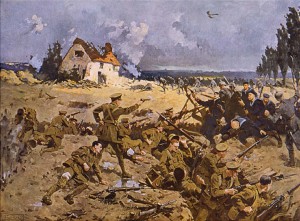 battle that Captain Harold Thorne Edwards replied to the German’s offer of surrender with the words, “Surrender be damned” and he and his men made the ultimate sacrifice. The scene of Captain Edwards and his men’s last stand is depicted in Fred Roe’s painting entitled “Surrender be damned” which was painted in 1935 after being commissioned by the South Wales Argus. It shows Captain Edwards firing his revolver at the advancing Germans. I believe the painting is now being displayed at the Newport Museum and Art Gallery after being hung in the foyer of Newport City council’s civic centre for many years.
battle that Captain Harold Thorne Edwards replied to the German’s offer of surrender with the words, “Surrender be damned” and he and his men made the ultimate sacrifice. The scene of Captain Edwards and his men’s last stand is depicted in Fred Roe’s painting entitled “Surrender be damned” which was painted in 1935 after being commissioned by the South Wales Argus. It shows Captain Edwards firing his revolver at the advancing Germans. I believe the painting is now being displayed at the Newport Museum and Art Gallery after being hung in the foyer of Newport City council’s civic centre for many years.
During research for the Newport’s War Dead website I came across a photograph in the South Wales Argus, 9th May 1947, of Alderman Mrs. Sarah J Haywood dedicating a plaque in front of members of the Old Comrades Association of the Monmouthshire Regiment in Bellevue Park, Newport. This may have been a plaque to replace an original one which would have been attached to a grove of eight may trees (hawthorns) that were planted in the 1920s as a memorial to those of the Monmouthshire Regiment that died on the 8th May 1915.
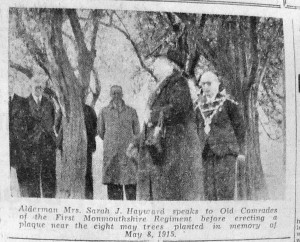
My inquiries about this memorial established that the trees had now either died off or were cut down. Unfortunately this meant that an event that caused great sorrow and sadness to the family and friends of these Newport men was now no longer commemorated.
I then started a campaign to get a new memorial to commemorate the battle of Frezenberg Ridge and the men who died on the 8th May 1915. My campaign was taken up by councillor Charles Ferris and numerous other friends including my daughter, Shelley. Finances were raised and on the 8th May 2015 a new memorial was dedicated on the banks of the river Usk opposite the Blaina Wharf pub in Newport. The event was attended by many dignitaries and military personnel.
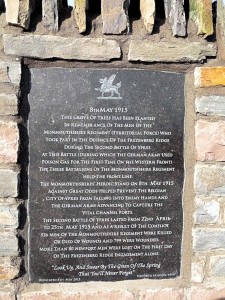
Inscription on the Memorial on Usk bank
8th May 1915
THIS GROVE OF TREES HAS BEEN PLANTED/ IN REMEMBERANCE OF THE MEN OF THE/ MONMOUTHSHIRE REGIMENT (TERRITORIAL FORCE) WHO/ TOOK PART IN THE DEFENCE OF THE FREZENBERG RIDGE/ DURING THE SECOND BATTLE OF YPRES./
AT THIS BATTLE (DURING WHICH THE GERMAN ARMY USED/ POISON GAS FOR THE FIRST TIME ON THE WESTERN FRONT)/ THE THREE BATTALIONS OF THE MONMOUTHSHIRE REGIMENT HELD THE FRONT LINE./ THE MONMOUTHSHIRES’ HEROIC STAND ON 8TH MAY 1915/ AGAINST GREAT ODDS HELPED PREVENT THE BELGIAN/ CITY OF YPRES FROM FALLING INTO ENEMY HANDS AND/ THE GERMANY ARMY ADVANCING TO CAPTURE THE VITAL CHANNEL PORTS./
THE SECOND BATTLE OF YPRES LASTED FROM 22ND APRIL/ TO 25TH MAY 1915 AND AS A RESULT OF THE CONFLICT/ 526 MEN OF THE MONMOUTHSHIRE REGIMENT WERE KILLED/ OR DIED OF WOUNDS AND 799 WERE WOUNDED./ MORE THAN 80 NEWPORT MEN WERE LOST ON THE FIRST DAY/ OF THE FREZENBERG RIDGE ENGAGEMENT ALONE./
Look Up, And Swear By The Green Of The Spring/ That You’ll Never Forget” – SIGFRIED SASSOON, 1919
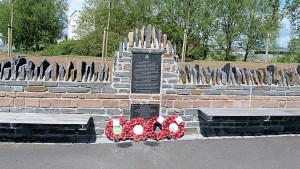
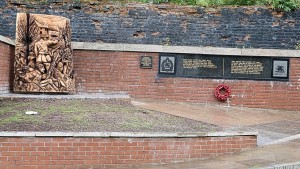
Earlier on the same day, a new wooden sculpture was unveiled at the old drill hall on Stow Hill, where these men had been recruited. It depicts the scene from Fred Roe’s painting of Captain Harold Thorne Edwards and his men’s stance against the oncoming German attack.
Meg Ryder April 4th, 2016
Posted In: memorials
Tags: Monmouthshire Regiment/ Catrawd Sir Fynwy, Newport/Casnewydd
WW1 Memorial in Y Tabernacl, the Welsh Baptist chapel in Cardiff
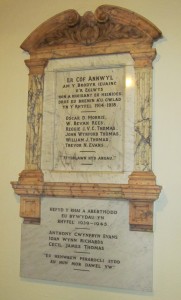 On a wall inside the Tabernacl, the Welsh Baptist chapel on the Hayes in central Cardiff, there is a memorial to the six men of the congregation who died in the Great War.
On a wall inside the Tabernacl, the Welsh Baptist chapel on the Hayes in central Cardiff, there is a memorial to the six men of the congregation who died in the Great War.
The memorial itself is impressive, being carved in marble.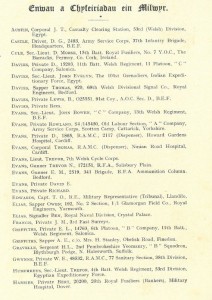
There are no records to indicate whether the chapel displayed a ‘Roll of Honour’ as the war was being fought, to highlight the contribution of a large number of the congregation to the war effort. However, the chapel’s Annual Reports do note the names of all the men who enlisted, and so we can trace how the war had a deeper effect every year on the congregation. There were 45 names on the list at the end of 1915, 62 by the end of 1916 and 66 in 1917 (including four who had been killed). The membership of the Tabernacl during the war fluctuated from around 520 to 560, so the total of 66 represents a sizeable proportion of the young male membership of the church.
List of chapel members serving in 1916
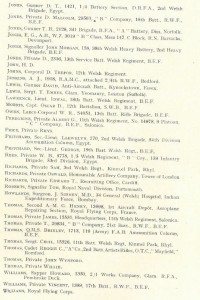
We can also see how the War’s impact became deeper and more painful from the minister’s comments in the reports. At the end of 1914 there was more discussion about the fire that had damaged the chapel than about the War, but the Rev Charles Davies’ comments became ever more emotional as the war dragged on and took an ever-increasing number of young men from his flock. Looking back upon 1916, he wrote that the young men left a large gap, and that their valuable contribution to the life of the chapel was deeply missed by those who were left. However, there is no doubt that the minister considered the war to be just, as he used such words as ‘teyrngarwch’ (loyalty), ‘dewrder’ (courage) and ‘aberth’ (sacrifice) to describe the men’s contribution to the war effort. He declared that as they faced the dangers and discomforts of the war, they were fighting ‘er amddiffyn ein gwlad, a sicrhau buddugoliaeth i gyfiawnder a gwir rhyddid yn ein byd’ (to defend our country, and to ensure a victory for justice and for the true freedom of our world).
In the lists of the men there is information about where a number of them were serving. At the end of 1916 a large number were in training camps in England or Wales; 14 with the BEF (British Expeditionary Force) on the Western Front; six in Egypt; four in Salonica and one in Bombay.
The first name on the memorial is Oscar D. Morris. It is possible to find a great deal of information about him: the letter he wrote as he sought to join the Welsh Army Corps are available on the Cymru1914 website – http://cymru1914.org/en/view/archive/4089505
One can also find a report on his promotion to lieutenant (August 1915 – http://cymru1914.org/en/view/newspaper/3886208/7/ART121) and then reports on his death on the Western Front on 21 April 1917 (http://cymru1914.org/en/view/newspaper/3886989/1/ART11 and http://cymru1914.org/en/view/newspaper/3886999/3/ART35 ). 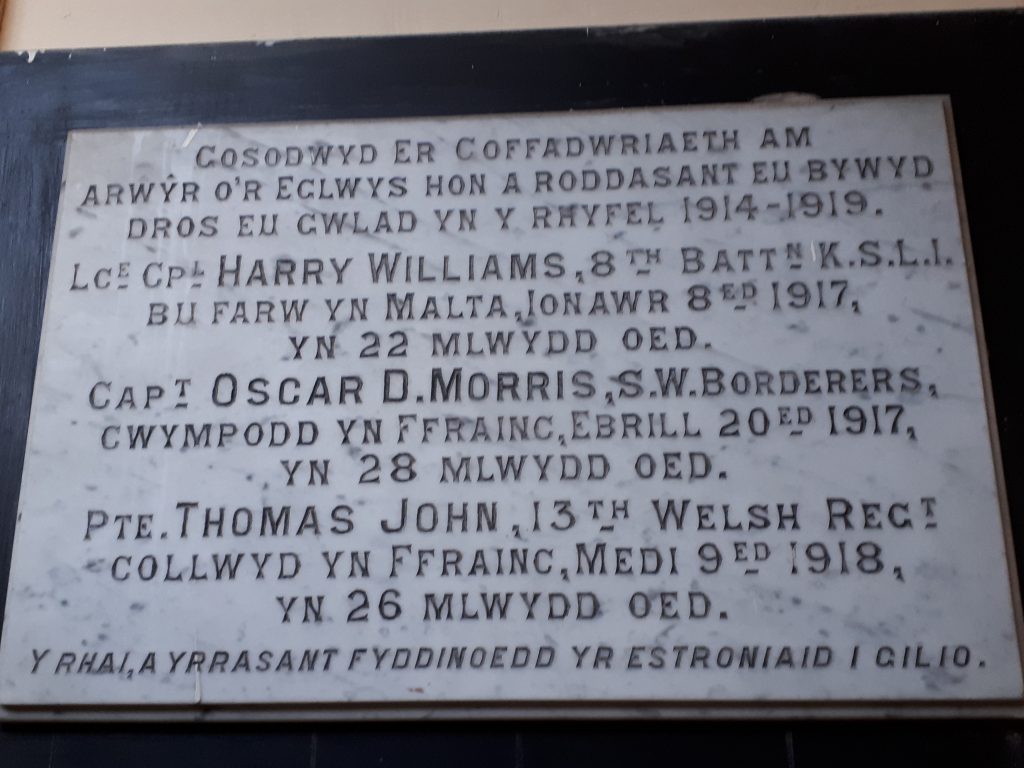
Oscar’s name is also to be found on the memorial in his home chapel – Salem Nantyffyllon.
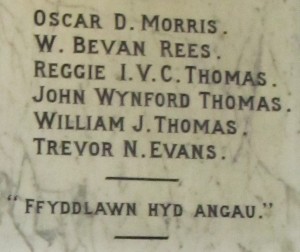 The second name is W. Bevan Rees, originally from Llandybïe, Carmarthenshire (who was 20 years old and working as a miner at the time of the 1911 census). He died in Palestine on 3 November 1917.
The second name is W. Bevan Rees, originally from Llandybïe, Carmarthenshire (who was 20 years old and working as a miner at the time of the 1911 census). He died in Palestine on 3 November 1917.
Reggie I.V.C.Thomas is the next name: he died on 24 November 1917 aged 19, while serving on the Western Front with the South Wales Borderers. He has no known grave, but his name is on the Cambrai memorial.
One can find John Wynford Thomas as a 12 year old boy in the 1911 Census, living in Lampeter Velfrey. There is no indication of when he moved to Cardiff, but he enlisted in the city, joining the South Wales Borderers. He was killed in Flanders on 31 October 1917.
Despite his common name, it is certain that the William John Thomas named on the memorial was an 18 year old who died on 11 July 1918 while serving with the Army Service Corps. He is buried in Cathays Cemetery, Cardiff.
However, the final name on the memorial is not on the list of the Commonwealth War Graves Commission. According to the Tabernacl’s records he was a soldier in 1916, serving as a Gunner with the RFA (Royal Field Artillery) on Salisbury Plain. The chapel’s report says that he died on 18 February 1919.
g.h.matthews March 22nd, 2016
Posted In: chapels / capeli, memorials, Uncategorized
Tags: chapels / capeli, memorials, WW1
Castle Steel Works, Rogerstone, War memorial
Numerous companies erected memorials to their employees who were killed in the First World War and Welsh companies, works, railways and other industrial employers are well represented in the range of known and surviving memorials.
One of the larger Welsh industrial employers of the opening decades of the twentieth century was Guest, Keen & Nettlefolds Ltd, which owned steelworks, engineering works and collieries located mainly in south east Wales. The company had been created in 1902 by the amalgamation of earlier companies, amongst them Nettlefolds Ltd, whose Birmingham factories dominated UK production of wood screws. The steel that formed Nettlefolds’ raw material was made in the company’s Castle Steelworks at Rogerstone, a short distance north west of Newport.
Castle Steel Works had opened in 1888 as the successor to an earlier iron works of the same name at Hadley near Wellington in 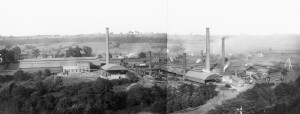 Shropshire when Nettlefolds converted from using wrought iron to using steel as the raw material for wood screw manufacture. Many of the workmen from the original Castle Works migrated to work in the new Castle Works, followed by their families. The ‘Shroppies’ secured many of the skilled jobs and formed a distinctive community within the Rogerstone area.
Shropshire when Nettlefolds converted from using wrought iron to using steel as the raw material for wood screw manufacture. Many of the workmen from the original Castle Works migrated to work in the new Castle Works, followed by their families. The ‘Shroppies’ secured many of the skilled jobs and formed a distinctive community within the Rogerstone area.
Photograph of the Castle Steel Works in 1902
Lloyd George, Minister of Munitions in the early part of the First World War, famously declared that Britain was ‘fighting a steel war’, so crucial was the availability of steel supplies to the war effort. From November 1915 most UK steelworks came under Government control, including Castle Works. In the early part of the war many steelworks reported labour shortages resulting from enthusiastic rates of volunteering. After the industry came under Government control, skilled men were mostly prevented from volunteering; after conscription began in 1916 unskilled men in essential industries, including steel, were increasingly ‘combed-out’ and conscripted.
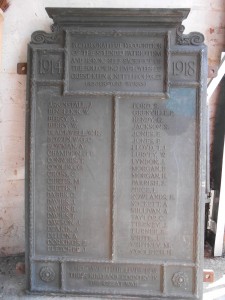 The Castle Steel Works memorial plaque lists many distinctively non-Welsh surnames and it is likely that descendants of the ‘Shroppies’ are well represented although it should also be recalled that the industrial areas of Monmouthshire experienced much emigration from Herefordshire and adjoining counties in the late nineteenth century and in the opening years of the twentieth century so not all the ‘English’ surnames necessarily originated in Shropshire.
The Castle Steel Works memorial plaque lists many distinctively non-Welsh surnames and it is likely that descendants of the ‘Shroppies’ are well represented although it should also be recalled that the industrial areas of Monmouthshire experienced much emigration from Herefordshire and adjoining counties in the late nineteenth century and in the opening years of the twentieth century so not all the ‘English’ surnames necessarily originated in Shropshire.
GKN commissioned similar bronze plaques for its other works, mines and factories. Whilst the wording (“In ever grateful recognition of the splendid patriotism and heroic self sacrifice of the following employees of Guest, Keen & Nettlefolds, Ltd.”, followed by the name of works) was consistent across all known plaques, the design of each plaque varied, especially with regard to the forms of the ornate borders and the arrangement of the fields in which the text (often divided in two), years, and lists of names were placed. There appears to have been a distinct policy of subtle variation within a broadly uniform ‘company design’. All the deceased are listed in alphabetical order by surname and forenames represented by initials.
The plaque is not inscribed with the name of the foundry that cast it. GKN possessed a number of foundries capable of producing this quality of casting and it is possible that the plaques were designed and cast in-house. It is at 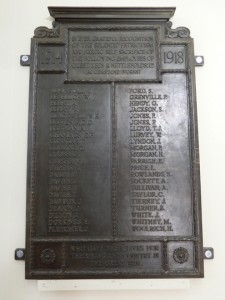 least equally likely that the plaques were commissioned from a specialist external foundry.
least equally likely that the plaques were commissioned from a specialist external foundry.
Comparison with GKN’s other sites suggests that the Castle Works plaque was probably placed in the steel works general offices. When the Rogerstone works was replaced by the third Castle Works in 1938, located in Cardiff, the plaque moved along with many of the employees. After the Cardiff works came under new ownership in 1981, the Castle Works general offices at Cardiff were demolished and the plaque was earmarked for scrap. It was saved by a private individual however and in 2015 was donated to Amgueddfa Cymru – National Museum Wales jointly by the individual and the successor company that owns Castle Works Cardiff.
Robert Protheroe Jones
Principal Curator – Industry
Department of History & Archaeology
Amgueddfa Cymru – National Museum Wales
Photographs of the memorial before and after conservation. Thanks to Amgueddfa Cymru – National Museum Wales for the images
g.h.matthews March 14th, 2016
Posted In: memorials, workplaces / gweithleoedd

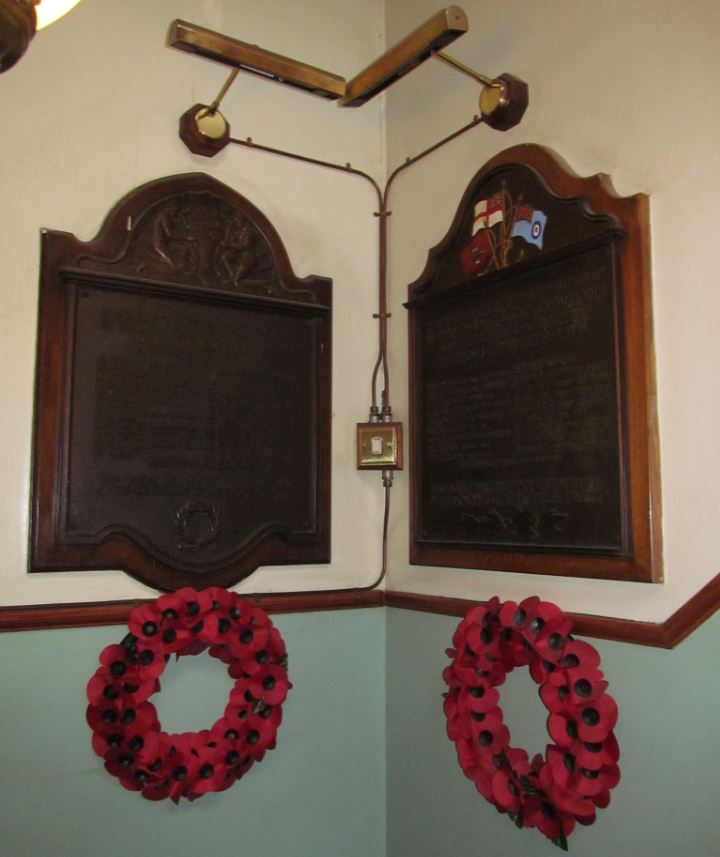
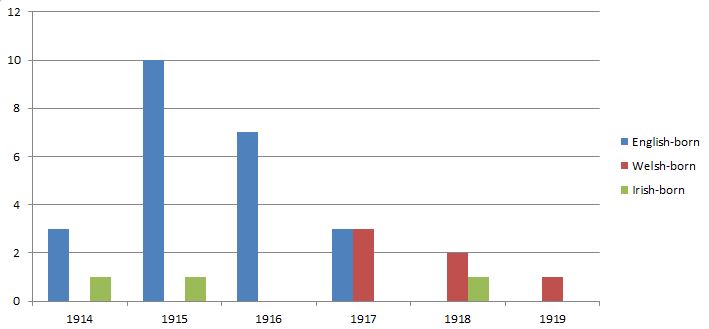


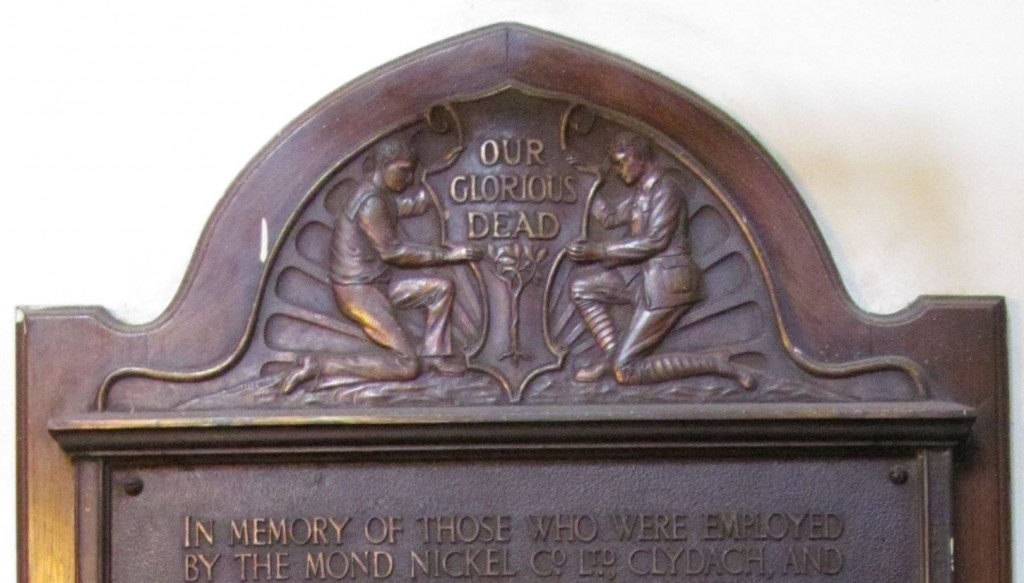
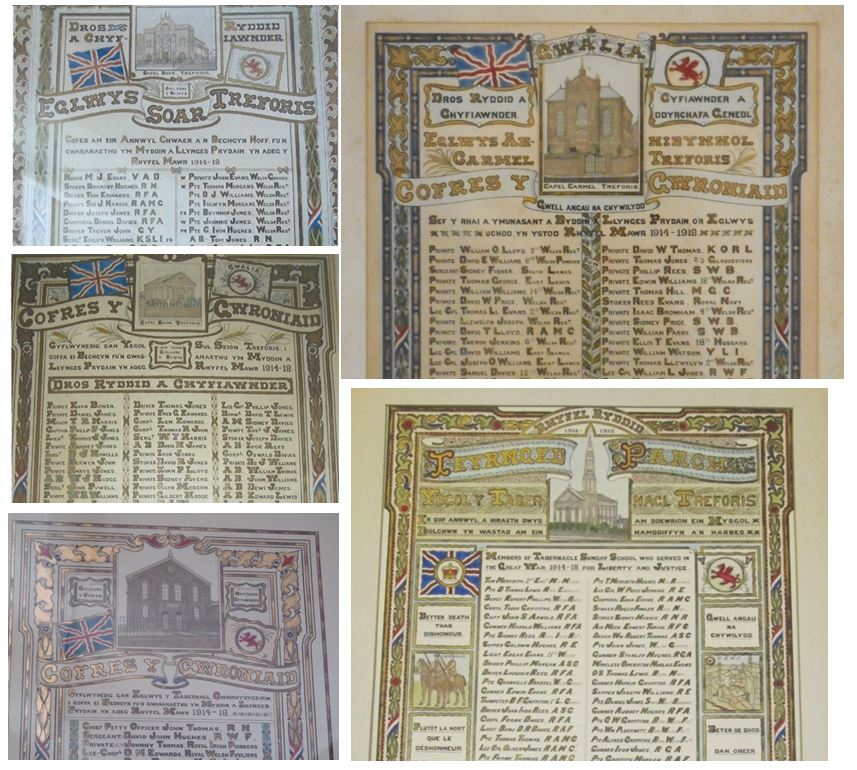
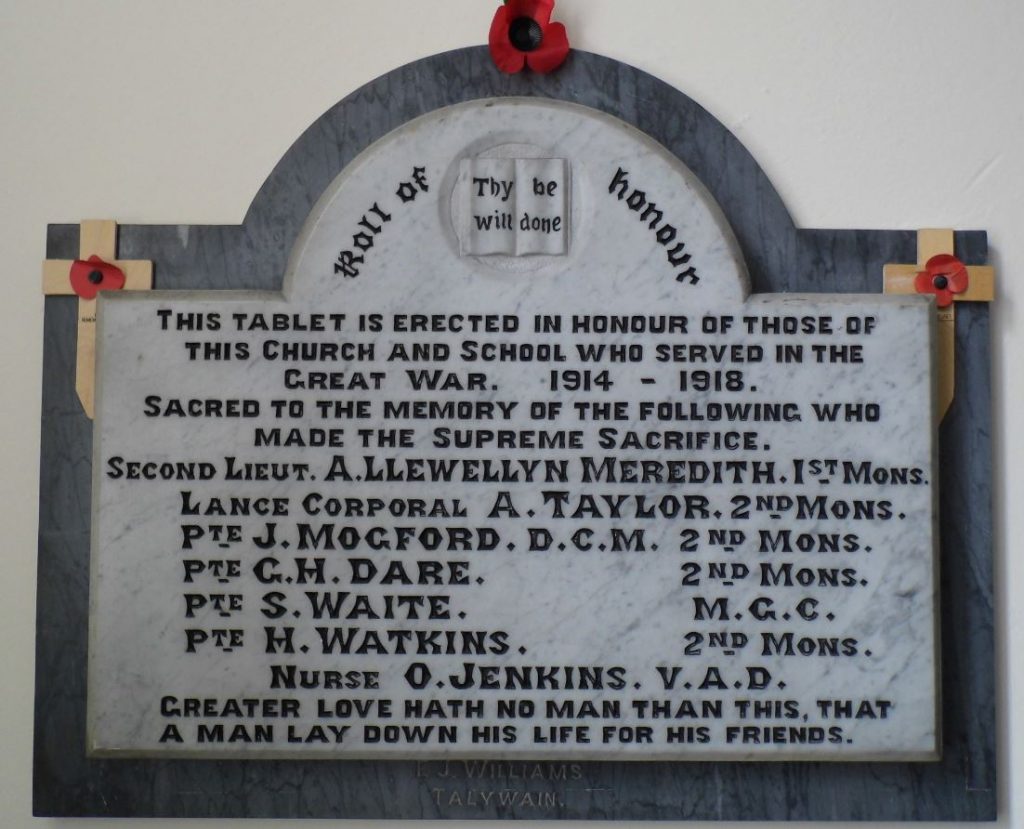
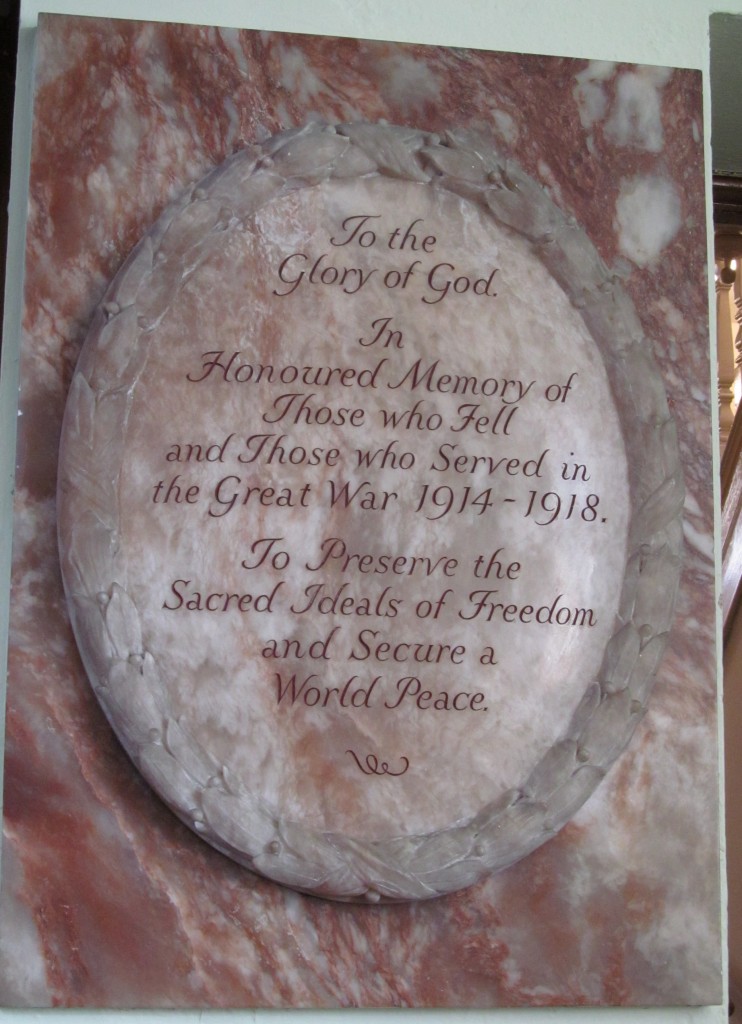
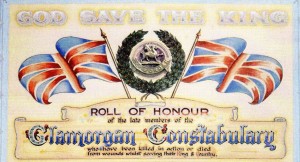

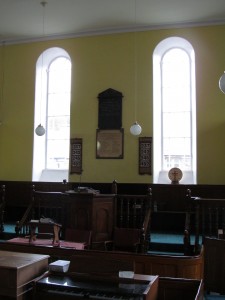 situated on the wall behind the pulpit, so that any worshipper who is looking at the minister will have the memorial in their line-of-sight.
situated on the wall behind the pulpit, so that any worshipper who is looking at the minister will have the memorial in their line-of-sight.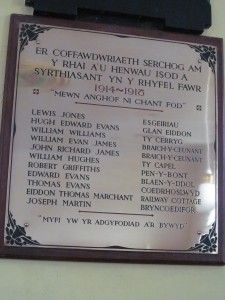 Esgeiriau
Esgeiriau